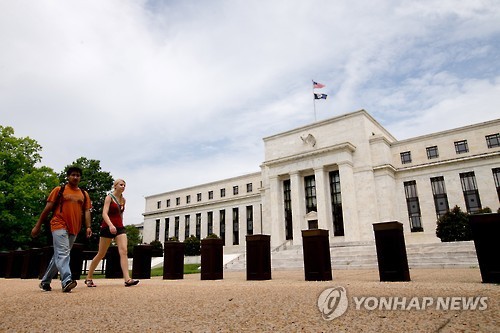The US economy is heading into 2018 with strong momentum that’s likely to boost wages and inflation more broadly, requiring the Federal Reserve to raise interest rates four times next year, Goldman Sachs Group economists said in a research note.
The New York-based investment banking and securities firm raised its growth outlook for 2018 to 2.5 percent and lowered its forecast for unemployment to 3.7 percent by the end of 2018, said Goldman chief economist Jan Hatzius, a co-author of the note, which was released by email late Friday.
 |
(Yonhap) |
Before the latest revision the most recent Goldman Sachs forecast for 2018 growth was 2.4 percent, according to forecasts compiled by Bloomberg.
The US jobless rate, which was 4.1 percent in October, may reach 3.5 percent in late 2019, Goldman predicted. That would be the lowest level since the late-1960s.
“Our projections would imply an evolution over the current cycle from the weakest labor market in postwar US history to one of the tightest,” the economists said in a summary of their report. “We expect that a tight labor market and a more normal inflation picture will lead the Fed to deliver four hikes next year.”
That’s one more rate increase than the median forecast of Fed officials, and more than financial markets are currently pricing in. One of the reasons why Goldman Sachs economists said they disagree with market expectations is “we see little evidence that soft inflation is structural in nature.”
Core inflation should accelerate in 2018, rising by about a half percentage point to 1.8 percent by year end, Goldman projected.
The Fed has raised its target range for the federal funds rate four times since December 2015, and futures trading indicates another quarter percentage-point increase is likely again in December, at the final Federal Open Market Committee meeting for the year.
In the world’s largest economy, the risk of a recession in the near term “still looks fairly limited,” the Goldman economists wrote. “But the strength is becoming ‘too much of a good thing’ and containing further overheating will become a more urgent priority in 2018 and beyond.” (Bloomberg)








![[Today’s K-pop] Blackpink’s Jennie, Lisa invited to Coachella as solo acts](http://res.heraldm.com/phpwas/restmb_idxmake.php?idx=644&simg=/content/image/2024/11/21/20241121050099_0.jpg)